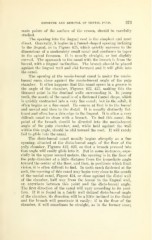Page 719 - My FlipBook
P. 719
EXPOSURE AND REMOVAL OF DENTAL, PULP. 373
main points of the surface of the crown, should be carefully
studied.
The opening into the lingual root is the simplest and most
direct. Generally, it begins in a funnel-shaped opening inclining
to the lingual, as in Figure 425, which quickly narrows to the
dimensions of a moderately small canal and continues to taper
to the apical foramen. It is usually straight, or but slightly
curved. The approach to the canal with the broach is from the
buccal, with a lingual inclination. The broach should be placed
against the lingual wall and slid forward and it will glide into
the canal.
The opening of the mesio-buccal canal is under the mesio-
buccal cusp, close against the mesio-buccal angle of the pulp
chamber. It often happens that this canal opens in a groove in
the angle of the chamber. Figures 422, 423, making this the
thinnest point in the dentinal walls surrounding it. In young
teeth, the mouth of the canal is of a flattened funnel shape, which
is quickly contracted into a very tine canal ; but in the adult, it
often begins as a fine canal. Its course at first is to the buccal
and mesial and then to the distal. It is usually distinctly flat-
tened and often has a thin edge to the lingual. It is often a very
difficult canal to clean with a broach. To find this canal, the
point of the broach should be directed into the mesio-buccal
angle of the pulp chamber, and, while held against the wall
within this angle, should be slid toward the root. It will rarely
fail to glide into the canal.
The disto-buccal canal usually begins abruptly as a fine
opening, situated at the disto-buccal angle of the floor of the
pulp chamber. Figures 422, 423, so that a broach pressed into
that angle will easily glide into it. But in some instances, espe-
cially in the upper second molars, the opening is in the floor of
the pulp chamber at a little distance from the immediate angle
toward the center of the floor, and then, in positions which limit
vision, it is often difficult to find. In teeth much flattened at the
neck, the opening of this canal may begin very close to the mouth
of the mesial canal. Figure 424, or close against the distal wall
of the chamber, half way from the buccal to the lingual wall,
or, anywhere between this point and the disto-buccal angle.
The first direction of the canal will vary according to its posi-
tion. If it is found in a fairly well defined disto-buccal angle
of the chamber, its direction will be a little inclined to the distal
and the broach will penetrate it easily; if in the floor of the
chamber, it will sometimes be straight, as in the former case;


